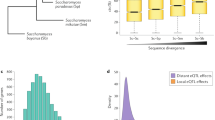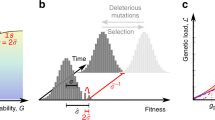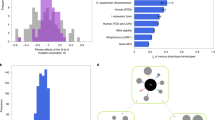Abstract
Genetic redundancy means that two or more genes are performing the same function and that inactivation of one of these genes has little or no effect on the biological phenotype. Redundancy seems to be widespread in genomes of higher organisms1,2,3,4,5,6,7,8,9. Examples of apparently redundant genes come from numerous studies of developmental biology10,11,12,13,14,15, immunology16,17, neurobiology18,19 and the cell cycle20,21. Yet there is a problem: genes encoding functional proteins must be under selection pressure. If a gene was truly redundant then it would not be protected against the accumulation of deleterious mutations. A widespread view is therefore that such redundancy cannot be evolutionarily stable. Here we develop a simple genetic model to analyse selection pressures acting on redundant genes. We present four cases that can explain why genetic redundancy is common. In three cases, redundancy is even evolutionarily stable. Our theory provides a framework for exploring the evolution of genetic organization.
This is a preview of subscription content, access via your institution
Access options
Subscribe to this journal
Receive 51 print issues and online access
$199.00 per year
only $3.90 per issue
Buy this article
- Purchase on Springer Link
- Instant access to full article PDF
Prices may be subject to local taxes which are calculated during checkout



Similar content being viewed by others
References
Brookfield, J. F. Y. Genetic redundancy. Adv. Genet. 36, 137–155 (1997).
Brookfield, J. F. Y. Can genes be truly redundant? Curr. Biol. 2, 553–554 (1992).
Tautz, D. Redundancies, development and the flow of information. BioEssays 14, 263–266 (1992).
Goldstein, D. B. & Holsinger, K. E. Maintenance of polygenic variation in spatially structured populations. Evolution 46, 412–429 (1992).
Thomas, J. H. Thinking about genetic redundancy. Trends Genet. 9, 395–399 (1993).
Dover, G. A. Evolution of genetic redundancy for advanced players. Curr. Opin. Genet. Dev. 3, 902–910 (1993).
Pickett, F. B. & Meeks-Wagner, D. R. Seeing double: appreciating genetic redundancy. Plant Cell 7, 1347–1356 (1995).
Bird, A. P. Gene number, noise reduction and biological complexity. Trends Genet. 11, 94–100 (1995).
O'Brien, S. J. On estimating function gene number in eukaryotes. Nature New Biol. 242, 52–54 (1973).
Kastner, P. et al. Nonsteroid nuclear receptors: what are genetic studies telling us about their role in real life? Cell 83, 859–869 (1995).
Rudnicki, M. A. et al. Inactivation of MyoD in mice leads to up-regulation of the myogenic HLH gene Myf-5 and results in apparently normal muscle development. Cell 71, 383–390 (1992).
Saga, Y. et al. Mice develop normally without tenascin. Genes Dev. 6, 1821–1831 (1992).
Yang, Y. et al. Functional redundancy of the muscle-specific transcription factors Myf5 and myogenin. Nature 379, 823–825 (1996).
Joyner, A. L. et al. Subtle cerebellar phenotype in mice homozygous for a targeted deletion of the En-2 homeobox. Science 251, 1239–1243 (1991).
Laney, J. D. & Biggin, M. D. Redundant control of Ultrabithorax by zeste involves functional levels of zeste protein binding at the Ultrabithorax promoter. Development 122, 2303–2311 (1996).
Schorle, H. et al. Development and function of T cells in mice rendered interleukin-2 deficient by gene targeting. Nature 352, 621–624 (1991).
Taniguchi, T. Cytokine signaling through nonreceptor protein tyrosine kinases. Science 268, 251–255 (1995).
Steindler, D. A. et al. Tenascin Knockout Mice: Barrels, Boundary Molecules, and Glial Scars. J. Neurosci. 15, 1971–1983 (1995).
Pekny, M. et al. Mice lacking glial fibrallary acidic protein display astrocytes devoid of intermediate filaments but develop and reproduce normally. EMBO J. 14, 1590–1598 (1995).
Reed, S. I. G1-specific cyclins in search of an S-phase promoting factor. Trends Genet. 7, 95–99 (1991).
Roche, S. et al. Requirement for Src family protein tyrosine kinases in G-2 for fibroblast cell division. Science 269, 1567–1569 (1995).
Fisher, R. A. The sheltering of lethals. Am. Nat. 69, 446–455 (1935).
Christiansen, F. B. & Frydenberg, O. Selection-mutation balance for two nonallelic recessives producing an inferior double homozygote. Am. J. Hum. Genet. 29, 195–207 (1977).
Bailey, G. S. et al. Gene duplication in tetraploid fish: model for gene silencing at unlinked loci. Proc. Natl Acad. Sci. USA 75, 5575–5579 (1978).
Allendorf, F. W. Protein polymorphism and the rate of loss of duplicate gene expression. Nature 272, 76–78 (1978).
Kimura, M. & King, J. L. Fixation of a deleterious allele at one of two duplicate loci by mutation pressure and random drift. Proc. Natl Acad. Sci. USA 76, 2858–2861 (1979).
Li, W.-H. Rate of gene silencing at duplicate loci: a theoretical study and interpretation of data from tetraploid fish. Genetics 95, 237–258 (1980).
Ohta, T. Time for spreading of compensatory mutations under gene duplication. Genetics 123, 579–584 (1989).
Li, X. & Noll, M. Evolution of distinct developmental functions of three Drosophila genes by acquisition of different cis-regulatory regions. Nature 367, 83–87 (1994).
Krakauer, D. C. & Pagel, M. Selection by somatic signals. Phil. Trans. R. Soc. Lond. B 351, 647–658 (1996).
Acknowledgements
We thank D. Krakauer and K. Sigmund for discussion. This work was supported by the Wellcome Trust (M.A.N.) and the European Community (M.C.B.).
Author information
Authors and Affiliations
Corresponding author
Rights and permissions
About this article
Cite this article
Nowak, M., Boerlijst, M., Cooke, J. et al. Evolution of genetic redundancy. Nature 388, 167–171 (1997). https://doi.org/10.1038/40618
Received:
Accepted:
Issue Date:
DOI: https://doi.org/10.1038/40618
This article is cited by
-
A parallel glycolysis provides a selective advantage through rapid growth acceleration
Nature Chemical Biology (2024)
-
Degeneracy measures in biologically plausible random Boolean networks
BMC Bioinformatics (2022)
-
Roles of transposable elements in the regulation of mammalian transcription
Nature Reviews Molecular Cell Biology (2022)
-
A Simple Evolutionary Model of Genetic Robustness After Gene Duplication
Journal of Molecular Evolution (2022)
-
Verbose exponence: Integrating the typologies of multiple and distributed exponence
Morphology (2022)
Comments
By submitting a comment you agree to abide by our Terms and Community Guidelines. If you find something abusive or that does not comply with our terms or guidelines please flag it as inappropriate.



